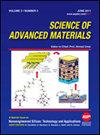Analysis of Targeted Therapy of Parkinson’s Disease with Coloaded Nanoparticles
IF 0.9
4区 材料科学
引用次数: 0
Abstract
The key to the treatment of Parkinson’s disease (PD) is delivering an effective amount of drugs into the brain to work, and supplementing the missing dopamine (Dop) in the brain is still the most effective treatment currently. In this research, borneol (Bor) was utilized to promote the drug to enter the brain through the nasal cavity, and lactoferrin (Lf) was utilized as the targeting molecule to modify the nanoparticles (NPs) so that they entered the brain and focused on the lesion site of PD to achieve targeting. They were then evaluated in vivo and in vitro , thus providing the basis for the development of the Lac-Bor/Dop NPs in PD therapy. In the experiment, the particle size of Lac-Bor/Dop NPs prepared by the optimal prescription process was 163.7±15.6 nm, the Dop drug loading was (7.86±1.68) %, and the Zeta potential was (−21.36±3.34) mV. The in vitro release confirmed that the Lac-Bor/Dop NPs had good sustained release characteristics in PBS medium. The cytotoxicity and uptake experiments confirmed that the cytotoxicity of Dop encapsulated in NPs was markedly inferior to that of free Dop ( P <0.05). For SH-SY5Y cells and 16HBE cells, Bor and Lf co-modified NPs can promote cell uptake. In vivo animal imaging counts confirmed that the coloaded NPs were capable of synergistic nasal drug delivery to the brain for better brain targeting. Furthermore, a PD model induced by dopaminergic neuron injury induced by unilateral striatal injection of 6-OHDA was constructed in rats and assigned into various groups to demonstrate the therapeutic effect of NPs on PD rats. The results revealed that relative to other groups, the contralateral rotations of rats in the Lac-Bor/Dop NP group were decreased drastically after 20 days of administration ( P <0.01), and the levels of Dop and dihydroxyphenylacetic acid (DOPAC) in the injured striatum were increased markedly ( P <0.01), demonstrating that the delivery system could achieve excellent PD therapy effects after nasal administration.复合纳米颗粒靶向治疗帕金森病的疗效分析
治疗帕金森病(PD)的关键是将有效量的药物输送到大脑中发挥作用,而补充大脑中缺失的多巴胺(Dop)仍然是目前最有效的治疗方法。本研究利用冰片(Bor)促进药物经鼻腔进入大脑,利用乳铁蛋白(Lf)作为靶向分子修饰纳米颗粒(NPs),使其进入大脑并聚焦于PD病变部位实现靶向。然后对它们进行体内和体外评价,从而为开发用于PD治疗的Lac-Bor/Dop NPs提供基础。实验中,采用最佳处方工艺制备的Lac-Bor/Dop NPs粒径为163.7±15.6 nm, Dop载药量为(7.86±1.68)%,Zeta电位为(−21.36±3.34)mV。体外释放证实Lac-Bor/Dop NPs在PBS介质中具有良好的缓释特性。细胞毒性和摄取实验证实,包裹在NPs中的Dop的细胞毒性明显低于游离Dop (P <0.05)。对于SH-SY5Y细胞和16HBE细胞,Bor和Lf共修饰的NPs可以促进细胞摄取。体内动物成像计数证实,负载的NPs能够协同鼻腔给药到大脑,从而更好地靶向大脑。建立单侧纹状体注射6-OHDA致多巴胺能神经元损伤大鼠PD模型,并将其分为不同组,以验证NPs对PD大鼠的治疗作用。结果显示,与其他组相比,Lac-Bor/Dop NP组大鼠在给药20 d后对侧旋转显著降低(P <0.01),损伤纹状体中Dop和二羟基苯乙酸(DOPAC)水平显著升高(P <0.01),表明该给药系统经鼻给药后可取得良好的PD治疗效果。
本文章由计算机程序翻译,如有差异,请以英文原文为准。
求助全文
约1分钟内获得全文
求助全文
来源期刊

Science of Advanced Materials
NANOSCIENCE & NANOTECHNOLOGY-MATERIALS SCIENCE, MULTIDISCIPLINARY
自引率
11.10%
发文量
98
审稿时长
4.4 months
 求助内容:
求助内容: 应助结果提醒方式:
应助结果提醒方式:


